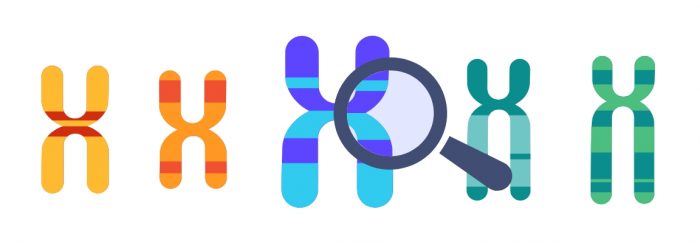Terry Pratchet, in his Discworld works, said that the city of Ankh-Morpork had a system of democracy based on “one man, one vote“; specifically, the man was the Patrician of the city and his vote was the only one that mattered. Monogenic diseases take the same view.
Monogenic diseases are diseases where one gene is responsible. One, single, individual, quantity, without the collaboration of others. Because of this they are also called Mendelian hereditary diseases (after Gregor Mendel) and single gene diseases. And what is a gene? A piece of DNA that contains information to code for a protein or the information needed to regulate its function. They have been defined as the fundamental unit of heredity and traits of individuals.
There are currently between 5,000-8,000 different monogenic diseases. Within the immune system alone, there are thought to be about 400 monogenic diseases, with 430 genes affected. Although each of the monogenic diseases has a different frequency, between them they are thought to affect 6% of the world’s population at some point in their lives. And unfortunately, for most of them, treatments are only palliative.

Not all alleles are equally authoritarian.
Depending on the gene responsible, they can be classified as follows:
- Autosomal dominant: a single copy of the gene, i.e., one allele, is sufficient to have the disease. For an individual to have the disease, at least one parent must also have the disease. Depending on which allele is transmitted, there is a 50% chance that the disease will be passed on to the offspring, with the patient having one normal and one pathological allele and the other parent being healthy. For further information on alleles, we recommend reading the sibling of this entry, Rare diseases: the frequent infrequent ones.
- Autosomal recessive: to have the disease, the individual needs both alleles to be pathological. A sick parent will always transmit a pathological allele to their offspring because both of their alleles are pathological. If one copy of the gene is normal, it compensates for the altered one and the individual does not have the pathology. These people are called carriers: they carry one allele of the disease, but do not express it. The offspring of a sick person is always a carrier (the other parent passed on a normal allele) or sick (the other parent passed on a pathological allele).
- On sex chromosomes: because sex always complicates everything. In the human species, the sex chromosomes are X and Y. Females are XX and males are XY. If the disease gene is on the Y chromosome, only males can have the disease, as females lack this chromosome. If the disease gene is on the X chromosome, the rules are similar to autosomal, with one difference. In boys, a recessive allele on the X is no different from a dominant allele: they only have one X chromosome, so they only have one copy. If you get the pathological allele, you get the disease regardless of whether it is recessive or dominant. In girls, on the other hand, who have two copies, a gene on the X chromosome behaves like an autosomal gene.
- If we want to get more complicated, we can add mitochondrial genetic diseases. Mitochondria are cell organelles that we receive only from our mother, and they have their own functional protein-coding genes. Fortunately, we don’t want to get complicated, and it’s too broad a topic, so for now it’s enough to mention that they exist.
Let’s get the dictionary out again because we’re going to explain penetrance. Penetrance is the proportion of individuals who, having a pathological mutation, have the disease. In our situation we can use it for autosomal dominant. If all people with the pathological allele show the disease, we would speak of 100% penetrance, complete penetrance. If out of every 100 people with that allele, there are 5 who do not have the disease, the penetrance would be 95%, incomplete penetrance. There is incomplete penetrance when we have more people carrying the mutated allele than sick people.
And another genetic term that is interesting is expressivity. Variable expression indicates that the disease does not manifest itself with the same identical symptoms in all individuals who have it. Variable expressivity therefore implies a range of symptoms that one person may have because of having the pathology, and which need not be identical to those of another with the same disease. Although due to a gene, other genetic and environmental components may be affected.
Which diseases are due to a single villain?
Some monogenic diseases are:
- Familial dysautonomia or Riley-Day syndrome. Autosomal recessive. The mutated IKBKAP gene on chromosome 9 is mutated and presents with symptoms from birth, which worsen over time. Patients with this disease have a very low number of neurons in the autonomic and sensory nervous system. Although there are many symptoms, such as habitual vomiting or the absence of tears when crying, one symptom is particularly striking: those affected are insensitive to pain.
- D-bifunctional protein deficiency. Autosomal recessive. Another neurodegenerative disease, here the HSD17B4 gene fails. The protein it produces is involved in the oxidation of fatty acids in a part of the cell called the peroxisome. This disease is considered the most severe peroxisome disorder, with a life expectancy of less than two years.
- Glycogenosis type 1a. Autosomal recessive. The responsible gene is G6PC or G6PC1. The protein under normal conditions has a simple function: it hydrolyses glucose-6-phosphate into glucose. Or, in other words, it is indispensable for the synthesis of glucose from glycogen stored as a reserve. This has two effects: on the one hand, low blood glucose levels and elevated acidosis due to the use of alternative energy sources. On the other hand, alterations in the organs that store glycogen, such as the liver and kidneys, which cannot do anything with it.
- Haemophilia A. Caused by mutations in the F8 gene, it is possibly the best-known X-linked recessive disease, which is why most reported cases are in males. There is a lack of blood clotting factor VIII (if anyone has trouble with Roman numerals, that’s an 8). Because of this, the blood cannot clot. Sick people cannot clot wounds and can suffer from spontaneous bleeding.
You can see the list of all monogenic diseases that the tellmeGen DNA kit tests for in case you want to check if you are a carrier of one of them. Genetic testing is the best way to prevent hereditary diseases. If you want to check if you suffer from the disease and have both mutated alleles, don’t worry: with most of them, you would have noticed it yourself. These are diseases that do not go unnoticed.



